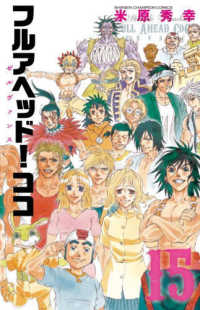- ホーム
- > 洋書
- > 英文書
- > History / World
Full Description
The CAA-GR 2024 Conference Proceedings capture the spirit and substance of the fifth national meeting on computer applications in archaeology and cultural heritage, held in Serres, Greece. Organized by the Athena Research Center and the International Hellenic University, the conference brought together a vibrant community of researchers, professionals, and practitioners exploring how digital technologies are reshaping our relationship and interaction with the past.
Under the theme "Transforming Heritage Research in a Transforming World," the volume reflects the urgent need for new approaches to the study and preservation of cultural heritage in the face of rapid technological advances, environmental challenges, and societal shifts. The chapters span a wide range of topics—from geophysical methods and risk management to 3D scanning, immersive visualization, digital tourism, and museum accessibility—highlighting the interdisciplinary and forward-thinking spirit that defines the field today.
Rich with innovative ideas, practical solutions, and theoretical reflections, this volume offers a compelling look at how computational tools are redefining the boundaries of archaeology and heritage studies. It is an essential resource for anyone interested in the digital transformation of the cultural sector and the future of heritage research.
Contents
Part 1: Field-based methods and geophysics.- Être à la temps! The use of mobile applications during surface surveys in Yambol province, Bulgaria.- Exploring the archaeological limit at the Amyklaion, Sparta/Greece: From pre-excavation methods through geophysics to a central documentation platform in a 3D environment.- "This place is not what it used to be". The everchanging road networks through the ages on Mount Nif and its surroundings.- Detection of archaeological surface ceramics using very high-resolution remotely sensed data.- Revisiting Terpni: Geophysics meets archaeology on Paliokastro Hill, an ancient city in the Lower Strymon Valley.- Sustainable, mindful, and reflective digital workflows for archaeological research in the Byzantine neighbourhood of the Pythion of Gortyn, Crete.- Part 2: Environment and risk management in heritage.- Monitoring environmental degradation of archaeological monuments using remotely sensed environmental observations: Insights from Delphi, Epidaurus, Olympia, and Aigai.- Geodetic benchmarks: A topic for scientific legacy in the future.- Evaluation of natural hazard risk on monumental structures: The case of the Rafina's Roman bath complex in Attica, Greece.- Part 3: 3D scanning and immersive visualization.- 3D documentation and 2D drafting of a post-Byzantine monument using LiDAR technology.- 3D documentation of a Byzantine Church in Kalampaka.- 3D documentation of the monument "Metochi of Agia Anastasia in Kritsiana of Epanomi".- 3D reconstruction of Thessaloniki's modern public baths.- 3D documentation of the Schwartz Mansion at Ampelakia, Larissa.- Deep learning-based monocular depth estimation in cultural heritage.- Limitations of SFM techniques for 3D modelling of archaeological excavations using UAV images.- Cultural metaverse experiences in archaeological sites.- Museatopia: A cultural metaverse.- Employing immersive technologies for successful cultural heritage promotion: Experience gained from previous cultural projects and the case of the v-Corfu Project.- A systematic study on the applications of virtual & augmented reality in art education.- Human-centric emotion recognition in VR for humanities research.- Techn'hom time machine. Reviving a spinning mill through augmented industrial heritage.- Enhancing cultural engagement: Mixed reality and mobile app innovations at the Acropolis of Tiryns.- Material insights: Exploring 3D digital methodologies on Minoan and Mycenaean seals and sealings.- Part 4: Digital tourism and cultural apps.- From archives to dark tourism: Routes in Athens and Attica.- Evaluating AR's impact on cultural tourism: The virtual Street Museum.- Enhancing cultural tourism recommendations: Design and evaluation of the ACUX-R mobile user interface.- Digicult: Digital storytelling of Aitoloakarnania's fortifications - Evaluation of interactive apps.- Part 5: Museum communication, accessibility, and education.- Museum accessibility for the visually impaired: The case of Greece and the contribution of innovative technologies.- Understanding the perceptions of Teachers regarding digital transformation in education & cultural heritage via mixed reality applications.- Modern approaches in museum social media data analysis.- Headlines: Crafting and assessing a cutting-edge iOS mobile application for cultural heritage daily news.- Digital challenges for small museums: The DigiSmALL approach.- Digital cultural apps and sustainability: Digistoryteller and its potential.- Digital stories for the BIRI collections: Methods, limitations and challenges.- Part 6: Aggregator-based documentation and heritage preservation.- Digital documentation of ecclesiastical cultural heritage: Insights from the NARRATE project.- Open access to the archaeological reasoning process. The naked archaeologist concept.- Exploration and digitization of the Pomak linguistic corpus.- Exploring active learning approaches in treebank development.- Travelling back to the origins of computer aided design: The digital preservation and representation of the NUMASURF milling machine.- Every good search tells a story: Creating virtual exhibitions on the Greek national cultural aggregator through query-based curation.- Unraveling the geographical maze: Extracting place information for enhanced metadata enrichment at SearchCulture.gr.







